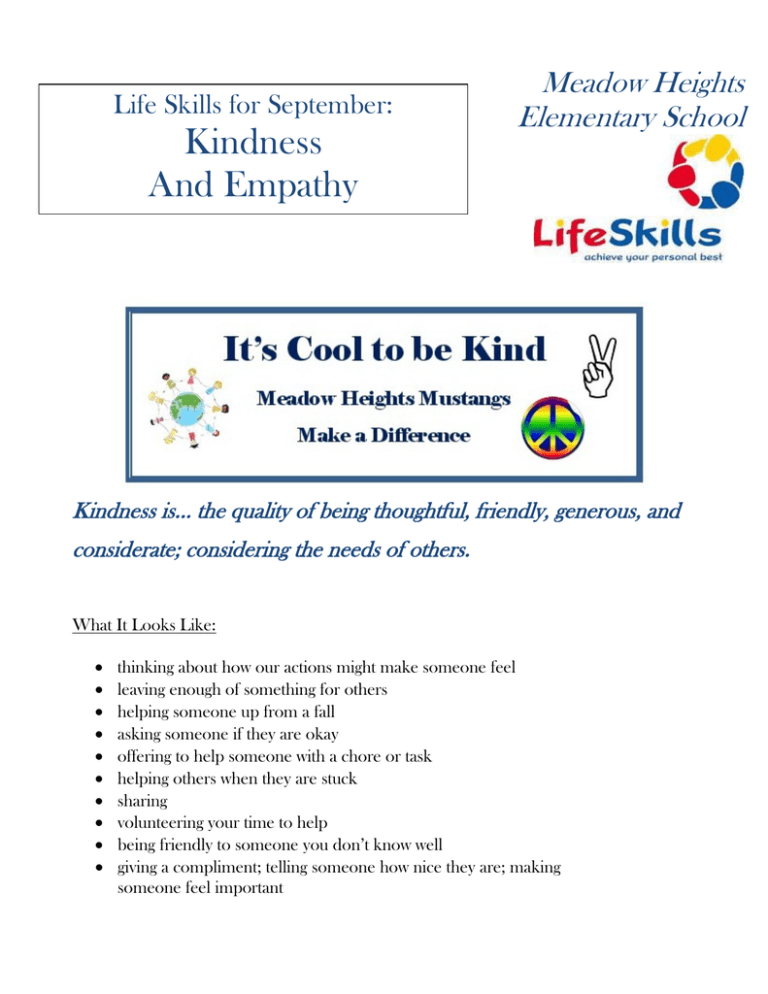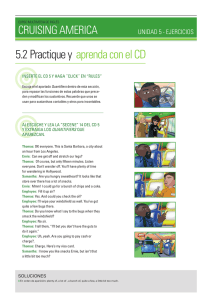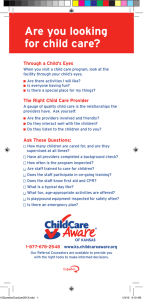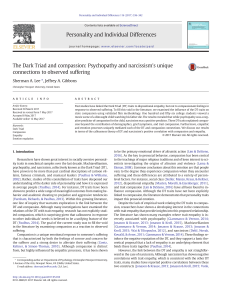Kindness And Empathy - Meadow Heights Elementary School PTA
Anuncio

Life Skills for September: Kindness And Empathy Meadow Heights Elementary School Kindness is… the quality of being thoughtful, friendly, generous, and considerate; considering the needs of others. What It Looks Like: thinking about how our actions might make someone feel leaving enough of something for others helping someone up from a fall asking someone if they are okay offering to help someone with a chore or task helping others when they are stuck sharing volunteering your time to help being friendly to someone you don’t know well giving a compliment; telling someone how nice they are; making someone feel important Activities to Do In Class or At Home: review definition and discuss what it “looks like” write about a time someone was kind to you and how you felt homework connection draw discuss / interview with parents or family Catch ‘Em In the Act – award with verbal praise or “Caught Being Kind” Cards Literature Link: A Chair for my Mother, Vera B. Williams Charlotte’s Web, E.B. White Her Father’s Garden, James Vollbrach King of the Golden River, John Ruskin Kids' Random Acts of Kindness, Conari Press The Recess Queen, Alexis O’Neill Way of the Circle, James Vollbrach It sure makes a difference when we all work together. Empathy is… considering how you would feel in someone else’s situation; taking time to imagine the feelings, thoughts, and attitudes of another. What can parents do to help their children develop empathy? Set an example. The best thing we can do as parents is be an example. When children have a problem, try to see things from their perspective. When they see you act with empathy, they are likely to copy you. You can also show them by being empathic with other people in their life. Create a loving home. When a child feels safe and happy at home, knowing their parents love them, they are less self-centered. When their own needs are met, they are more likely to think of others before themselves. Tell your children you love them; listen to them and give them your attention. When parents listen, their children learn to have more empathy. Spend time with your children by playing games with them and reading to them. Being able to connect to others is a skill that helps them be empathic towards others. Give service. One activity for any age to build empathy is to give service. Helping at a soup kitchen as a family helps your children see other ways of life, |helping them to build empathy towards those who are less fortunate. You can also leave cookies anonymously for someone you know who has been down. The point is to encourage your children to help others; even if they do not feel empathy at first, it will grow as they do it. Spend time with animals. Another great thing for children is to have experience with animals. Learning compassion and caring for animals encourages the development of similar feelings in dealing with children. Encourage them. Positive reinforcement of empathy is also helpful. You can say, "I really appreciate how you shared your crackers with Sarah when she didn't have any. That was very nice of you." Helping the child to see that you approve of their behavior will encourage them to be empathic in the future. Role play. You can help your kids practice empathy by using role-play. This is as simple as asking, "How would you feel if someone did that to you?" or reading them a story and asking them to describe the feelings of the characters. Read with them. Read stories together and talk about the characters’ feelings and situations. Learning to recognize the feelings of other people is important to showing empathy. Many stories have a theme about helping others or being empathic. You can even look through the books your child already has to find books that teach empathy. By listening to any story, children learn to see a situation from another's point of view. (Taken from an article Written by Kaitlin M. Miller, Research Assistant, and edited by Laura Padilla-Walker and Stephen F. Duncan, professors in the School of Family Life, Brigham Young University, http://foreverfamilies.byu.edu) Literature Link: Always Room for One More by Sorche Nic Leodhas Angelica’s Wish, by Annette Menniti Campbell Be Quiet, Marina!, by Kirsten Debear The Boy Who Grew Flowers by Jennifer Wojtowicz Buddy Unchained, by Daisy Bix Masai and I, by Virginia Kroll Priscilla McDoodlenutDoodleMcMae Asks Why? by Janet Mary Sinke Storm Boy, by Colin Thiele Teaching Children Empathy, The Social Emotion: Lessons, Activities and Reproducible Worksheets (K-6) That Teach How to "Step Into Others' Shoes," by Tonia, Ph.D. Caselman We're All In the Same Boat by Zachary Shapiro "You never really understand a person until you consider things from his point of view... until you climb into his skin and walk around in it." - Harper Lee, To Kill a Mockingbird It sure makes a difference when we all work together. Habilidades de por Vida de Septiembre: Meadow Heights Elementary School Amabilidad y Empatía Consideración es … la calidad de ser amable, amistoso, generoso y considerado ; considerando las necesidades de los otros. Cómo Se Ve: pensando acerca de como nuestras acciones hacen sentirse a otra persona dejando lo suficiente de algo para otros ayudando a una persona a levantarse de una caída preguntando a alguien si está bien ofreciendo ayuda a alguien con sus tareas o trabajo ayudando a otros cuando están trabados compartiendo dando su tiempo como voluntario para ayudar siendo amigable con alguien que no conoces tan bien dando un cumplido; diciendo que simpáticos son; haciendo que alguien se sienta importante Actividades para hacer en la Casa: revisar definiciones y discutir “como se ve” escribir acerca de la vez cuando alguien fue bondadoso contigo y como te sentiste conexión dibujar discutir /entrevista con los padres o familia Agarrándolos En el Acto– premio con un elogio verbal o Tarjetas “Agarrándolos En el Acto” Enlace de Literatura: A Chair for my Mother, Vera B. Williams Charlotte’s Web, E.B. White Her Father’s Garden, James Vollbrach King of the Golden River, John Ruskin Kids' Random Acts of Kindness, Conari Press The Recess Queen, Alexis O’Neill Way of the Circle, James Vollbrach Por cierto hace una diferencia cuando todos trabajamos juntos. Empatía es… considerando como te sientes en la situación de otra persona; tomando tiempo para imaginar los sentimientos, pensamientos y actitudes de otro. ¿Qué pueden hacer los padres para ayudar a sus niños a desarrollar empatía? Dar el ejemplo. La mejor cosa que los padres pueden hacer es dar el ejemplo. Cuando los niños tienen un problema, traten de ver las cosas desde las perspectivas de ellos. Cuando ellos los ven a ustedes actuar con empatía, ellos querrán copiarlos a ustedes. También pueden mostrarles identificándose con otras personas en su vida. Creando un hogar con amor. Cuando un niño(a) se siente feliz y seguro en la casa, sabiendo que sus padres lo quieren, ellos están centrados en sí mismos. Cuando se alcanzan sus necesidades, es más probable que piensen en otros antes que en ellos mismos. Digan a sus niños que los quieren; escúchelos y presenten atención a ellos. Cuando los padres escuchan, los niños tienen más empatía. Tomen tiempo con sus niños jugando juegos y también leyendo con ellos. Pudiendo conectarse con otros es una habilidad que les ayuda a tener empatía hacia otros. Dar servicios. Una actividad para cualquier edad para aumentar la empatía es dar servicios. Ayudando en una cocina para personas sin recursos que necesitan comida, como familia, ayuda a sus niños a ver otras maneras de vidas, |ayudándoles a aumentar la consideración para otros menos afortunados. también pueden dejar galletitas de manera anónima para alguien que está pasando por malos momentos. El punto principal es el de alentar a sus niños a ayudar a otros; aun cuando no lo sientan al principio, esto aumentará cuando lo hacen Tomar tiempo con animales. Otra cosa muy buena para los niños es tener experiencia con animales. Aprendiendo compasión y cuidando de los animales alienta el desarrollo de sentimientos similares, cuando tratan con otros niños. Aliéntenlos. Es de mucha ayuda el refuerzo positivo de empatía. Usted puede decir “Yo realmente aprecio como has compartido tus galletas con Sarah, cuando ella no tenía ninguna. “Esto es muy lindo de tu parte." Ayudando a su niño(a) a ver que ustedes aprueban su conducta, lo/ la alentará a ser considerado en el futuro. Jugar Roles. Ustedes pueden ayudar a sus niños a practicar empatía usando el juego de roles. Esto es tan simple como preguntando, "¿Cómo te sentirías si te hicieran esto a tí ?" o leyéndoles historias y haciendo que ellos describan sus sentimientos o los de los personajes. Leyéndoles a ellos. Leer historias juntos y platicar acerca de los sentimientos y situaciones de los personajes. Aprendiendo a reconocer los sentimientos de otras personas es importante para mostrar empatía. Muchas historias tienen un tema acerca de ayudar a otros o tener empatía. Hasta pueden buscar a través de los libros que su niño(a) ya tiene, para encontrar libros que enseñan empatía. Escuchando cualquier historia, los niños aprenden a ver una situación desde el punto de vista de otros. (Tomado de un artículo escrito por Kaitlin M. Miller, Asistenta de Investigación y editado por Laura Padilla-Walker y Stephen F. Duncan, profesores en la Escuela de Vida Familiar en la Universidad de, Brigham Young, http://foreverfamilies.byu.edu) Enlaces de Literatura: Always Room for One More por Sorche Nic Leodhas Angelica’s Wish, por Annette Menniti Campbell Be Quiet, Marina!, por Kirsten Debear The Boy Who Grew Flowers por Jennifer Wojtowicz Buddy Unchained, por Daisy Bix Masai and I, por Virginia Kroll Priscilla McDoodlenutDoodleMcMae Asks Why? por Janet Mary Sinke Storm Boy, por Colin Thiele Teaching Children Empathy, The Social Emotion: Lecciones, Actividades y Hojas de trabajo que se pueden reproducir (K-6) That Teach How to "Step Into Others' Shoes," -por Tonia, Ph.D. Caselman We're All In the Same Boat por Zachary Shapiro "Nunca entenderás a una persona hasta que consideres las cosas desde su punto de vista... hasta que escales en su piel y camines a su alrededor." - Harper Lee, To Kill a Mockingbird Seguro que hace una diferencia cuando trabajamos juntos I.











